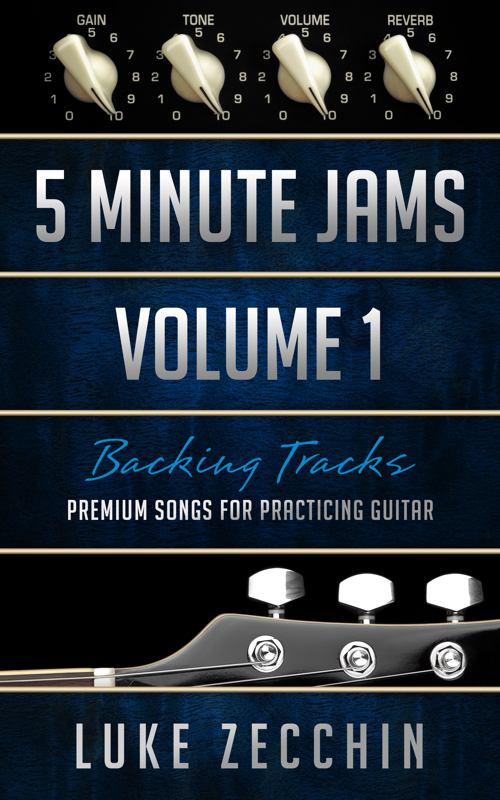Tips for ImprovisationThere are numerous benefits of incorporating jam tracks into our practice time. While backing tracks shouldn’t be seen exclusively as a tool for improvising, improvisation does warrant special attention. Why? Because it provides a valuable critique on our playing as a whole. Improvisation requires that our playing technique, skills at fretboard navigation, and musical intuition all work together. It’s also an immediate and effective way to experiment with new patterns, techniques, and concepts. Beyond this, most importantly, it’s fun! Improvisation, by its very nature, is defined by spontaneity; it’s a free-form musical expression. As such, it’s difficult to definitively outline a correct approach to improvising over a piece of music. Creativity, after all, is completely subjective! Having said that, if we’re looking to craft solos that are just as enjoyable to listen to as they are to play, there are some fundamental concepts that recur across many genres and playing styles. Improvisation, like all aspects of learning guitar, is a skill that needs to be practiced. Finding your own voice on the guitar requires learning how to speak the language of music fluently. As you work through these backing tracks, here are some key points worth considering: 1 | Think Melody First: A keen sense of melody is the difference between sounding like you’re playing scales and sounding like you’re playing music. Concentrating on melody brings focus to your musical ideas and creates a more engaging interaction with the listener. 2 | Emotion Is Key: The feel and emotion of how something is played say equally as much as what’s played. Sometimes, simpler musical ideas played with feeling communicate significantly more than overly complex phrases, regardless of the technical proficiency they may require. 3 | Focus on Dynamics: Dynamics are a central channel through which feeling is conveyed. They encompass a wide range of sonic variances: loud, soft, simple, complex, tense, resolved, fast, and slow, for example. A dynamic performance will draw on various modes of expression. 4 | Concentrate on Phrasing: Melodic ideas should communicate something. Sensitivity to phrasing is what separates non-musical meanderings from coherent musical statements. Think about improvisation in terms of a conversation, where melodic statements are made and then responded to. 5 | Make Use of Repetition: Establishing, revisiting, and embellishing similar melodic themes throughout a song are key tools in songwriting. Not only does this type of repetition provide more mileage from a single melodic idea, but it also introduces structure and familiarity into a performance. 6 | Be Sensitive to Space: We often have a tendency to overplay, to fill up every space between phrases. This can confuse the main melodic ideas we’re trying to express and become quite tiresome to listen to. Often, what you don’t play says just as much as what you do play. 7 | Technique Is a Tool: Ultimately, technique should support musicality, not replace it. It’s easy to develop an unbalanced fascination with speed and other technical aspects of guitar playing. While efficient and accurate technique is essential, it should never be the end goal itself. 8 | Don’t Ignore Theory: While theory is no substitute for creativity, it provides the foundation for it. Understanding the essentials of how chords and scales are related will shape the essence of your musical vocabulary. Music theory informs and underpins everything we do on guitar. 9 | Practice Creativity: Creativity is a way of thinking. Train yourself to play with your ears, not your fingers. Our fingers always gravitate toward the familiar patterns and ideas they’re used to playing. Try to practice hearing melodic ideas in your head before you play them on the fretboard. 10 | Remember to Listen: For a musician, listening is as important as playing. Music has an innate ability to tell you where it needs to go. Paying careful attention to the movement and instrumentation surrounding what you play will help ensure that a song sounds cohesive as a whole. Copyright © 2016 Luke Zecchin
Comments are closed.
|
Articles10 Chord Mastery Tips!
Guitar Chords 101 10 Memorization Tips Fretboard Memorization Fretboard Anatomy 101 Guitar Setup Basics 4 Keys to Great Playing! FREE Jam Tracks! 10 Tips for Better Solos Playing vs Practice 10 Scale Mastery Tips! Guitar Scales 101 3 Simple Guitar EQ Tips Rode NTR Mic Review iZotope RX - On Guitar Dealing with Latency Slate VCC | VTM Review GarageBand v Logic X 5 FREE Guitar Plugins Logic Pro X for Guitar Pedals vs Multi-Effects How to Roll Leads Stop Breaking Strings? When to Change Strings Using Neck Diagrams 5 Essential Tuning Tips 7 Beginner Mistakes |







